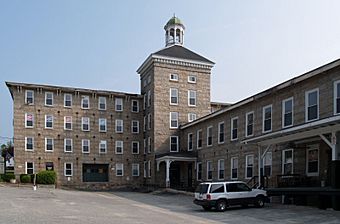Manchaug Village Historic District facts for kids
Quick facts for kids |
|
|
Manchaug Village Historic District
|
|

Manchaug's stone mill
|
|
| Location | Roughly bounded by Putnam Hill, Whitins, Morse, Mumford & Manchaug Rds. Ledge, Main, 3rd & Maple Sts., Stevens Pond, Sutton, Massachusetts |
|---|---|
| Architectural style | Federal, Greek Revival, Italianate |
| NRHP reference No. | 100002026 |
| Added to NRHP | January 16, 2018 |
The Manchaug Village Historic District is a special area in Sutton, Massachusetts. It shows what a busy factory town looked like in the 1800s. This district grew around textile mills (factories that made cloth) on the Mumford River. It was the biggest industrial spot in Sutton. At least three large mill complexes worked here. The center of the district is where Main Street meets Manchaug, Putnam Hill, and Whitins Roads.
What's in a Name? The Story of Manchaug
Manchaug was once a special village for the Nipmuc people. It was set up by the Massachusetts Bay Colony in the 1670s. This area is now part of Oxford, Massachusetts. After a big conflict called King Philip's War, many people left the village. The land was then sold to other people.
But the name "Manchaug" lived on. It became the name of Manchaug Pond. Later, in the 1800s, a company called the Manchaug Company started. They built factories near the pond. The pond was the source of water for their mills. Because of this, the factory town became known as Manchaug Village.
Manchaug Village: A Look Back in Time
Before the 1800s, Manchaug Village was mostly farmland. There was only one small factory on the Mumford River in 1795. It was a trip hammer shop. This kind of shop used water power to hammer metal.
In 1826, some business people from Rhode Island started buying land. They also bought the rights to use the river's water. They wanted to build textile mills. The stone mill you can see at 9 Main Street was built that same year. Soon after, homes were built for the mill workers.
The mills grew much bigger in the 1850s and 1860s. A dam was built to create Stevens Pond. New mills were added, and many more houses for workers were built. The mills did very well until after World War I. They finally closed in 1921. The company then sold off all the houses they owned in 1927.
The historic district today centers on the main crossroads. This is where Main Street meets Manchaug, Putnam Hill, and Whitins Roads. Around this area, you can still see the old mills and worker homes. The mill buildings are usually large and made of stone. The worker houses are often wooden buildings with sloped roofs. These houses were made for several families to live in.
The mill owners also built some single-family homes. These were for people who managed the mills or had special skills. The Greek Revival style Manchaug Baptist Church is also in the district. It was built in 1842 for the mill workers. It is one of the few buildings not directly linked to the mills.



